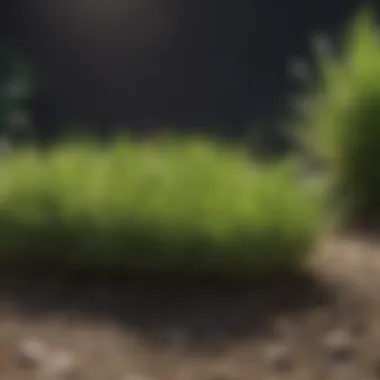Materials:
To start the process of turning a barren dirt backyard into a vibrant green lawn, you will need the following materials meticulously gathered for a successful transformation:
- 500 lbs of high-quality topsoil
- 10 lbs of compost for soil enrichment
- 50 lbs of grass seed suitable for your climate
- 1 garden rake for soil leveling
- 1 shovel for digging and mixing
- 1 sprinkler system or hose for watering
DIY Steps:
Once you have all the necessary materials at hand, follow these precise instructions to kickstart your grass-growing journey:
- Begin by clearing the backyard area of any debris or rocks to create a clean canvas for grass growth.
- Use the garden rake to spread the topsoil evenly across the dirt surface, ensuring a smooth and level base.
- Incorporate the compost into the soil, mixing it thoroughly to enhance its nutrient content for optimal grass development.
- Sprinkle the grass seeds generously over the prepared soil, following the recommended seeding rate for lush coverage.
- Gently rake the soil covering the seeds to a depth of 14 inch to secure them in place for germination.
Technical Aspects:
For a successful grass-growing project, make sure to pay attention to these technical aspects to elevate the quality of your DIY endeavor:
- Timing is crucial; choose the right season for sowing grass seeds to maximize their growth potential.
- Utilize a specialized seed spreader for accurate and uniform seed distribution across the soil surface.
DIY Project Process:


As you progress through the project, adhere to these sequential steps to ensure a smooth and error-free process:
- Water the seeded area gently but consistently to keep the soil moist for optimal seed germination.
Troubleshooting Tips:


In case you encounter common issues during the grass-growing process, consider the following troubleshooting tips to maintain the health of your grass:
- If patches of grass appear sparse, reseed those areas to promote uniform growth.
- Monitor water drainage in the area to prevent waterlogging, which can hinder grass development.
Understanding the Soil


In the quest to turn a barren dirt backyard into a vibrant green sanctuary, understanding the soil is the pivotal first step. By comprehending the composition of the soil and its quality, one can effectively lay the groundwork for successful grass cultivation. The soil serves as the foundation for healthy root development and nutrient absorption, significantly impacting the growth and vitality of the grass. Therefore, an in-depth understanding of the soil is crucial in ensuring the optimal conditions for a flourishing lawn.
Assessing Soil Quality
Conducting a Soil Test
Delving into the realm of assessing soil quality, conducting a soil test emerges as a fundamental action. This procedure involves gathering soil samples from various spots in the backyard and analyzing them to determine essential elements like p H levels, nutrient content, and soil structure. The data extracted from these tests aids in customizing the soil preparation process, ensuring that the grass receives precisely what it needs to thrive. Conducting a soil test is a precise and scientific approach that empowers homeowners to make informed decisions regarding soil amendments and fertilizer applications, ultimately leading to a sustainable and verdant lawn.
Identifying Soil Deficiencies
Another vital aspect of assessing soil quality is identifying soil deficiencies. By pinpointing specific shortcomings such as nutrient imbalances or soil compactness, individuals can address these issues proactively. This proactive stance allows for targeted solutions to rectify deficiencies, whether through organic amendments, compost additions, or specific nutrient applications. Understanding and rectifying soil deficiencies play a pivotal role in setting the stage for robust grass growth and resilience to environmental stressors, forming the backbone of a successful lawn cultivation journey.
Soil Preparation
Embarking on the soil preparation phase, clearing debris and rocks stands out as an indispensable task. This process involves removing any obstacles that hinder grass root growth, such as stones, branches, or old plant remnants. Clearing debris ensures a clean canvas for the grass seeds to take root, enabling unobstructed growth and promoting uniformity in the lawn. While labor-intensive, this step lays the groundwork for a visually appealing and well-established grass landscape.
In tandem with debris removal, aerating the soil emerges as a crucial practice in soil preparation. Aerating involves perforating the soil to alleviate compaction and enhance air circulation to the roots. This process creates pathways for water, oxygen, and nutrients to penetrate deeply into the soil, fostering robust root systems and overall grass health. Aerating the soil promotes optimal growth conditions, enabling the grass to establish strong roots and thrive in the backyard environment.
Choosing the Right Grass Seeds
Choosing the right grass seeds is a crucial step in the process of growing grass in a dirt backyard. The type of grass you select will impact the overall look, maintenance requirements, and resilience of your lawn. Whether you opt for warm-season grass or cool-season grass, understanding the specific characteristics of each type is essential for achieving a healthy and vibrant lawn.
Grass Types
Warm-season grass
Warm-season grass thrives in hot climates and is known for its ability to withstand drought conditions. This grass type is ideal for regions with long, hot summers where water conservation is a priority. The key characteristic of warm-season grass is its high heat tolerance, making it a popular choice for homeowners looking for a low-maintenance lawn option. However, one disadvantage of warm-season grass is its slower growth in cooler temperatures, which can result in browning during colder months.
Cool-season grass
Cool-season grass, on the other hand, is best suited for regions with moderate temperatures and cold winters. This type of grass remains green throughout the year, providing a visually appealing lawn even during cooler seasons. The key characteristic of cool-season grass is its ability to thrive in cooler climates, making it a popular choice for homeowners who want a lush lawn year-round. However, cool-season grass may struggle in extreme heat and drought conditions, requiring more water and maintenance to stay healthy.
Seed Selection
Considering sunlight requirements
When selecting grass seeds, it's essential to consider the sunlight requirements of the chosen grass type. Some varieties require full sun exposure, while others can tolerate partial shade. Understanding the sunlight needs of your selected grass seeds will help ensure successful growth and optimal performance in your backyard. Choosing seeds that match your yard's sunlight conditions can promote lush and healthy grass growth.
Resilience to foot traffic
Another crucial factor to consider when selecting grass seeds is resilience to foot traffic. If your lawn experiences heavy use, such as children playing or frequent gatherings, opting for seed varieties that are specifically designed to withstand foot traffic is advisable. These seeds are typically more hardwearing and can recover quickly from damage, ensuring your lawn remains robust and green even in high-traffic areas.
Planting and Maintenance
In the realm of growing grass in a dirt backyard, the planting and maintenance phase holds paramount significance in ensuring the successful establishment and longevity of your lawn. The meticulous attention given to planting and subsequent maintenance activities are essential for fostering healthy grass growth and vibrant greenery that adorns your outdoor space. Planting does not merely involve scattering seeds haphazardly but rather necessitates a strategic approach that includes proper seeding techniques and adhering to a consistent watering schedule. Furthermore, maintenance practices such as regular mowing and timely fertilization play a pivotal role in preserving the lushness of your grass and enhancing its overall resilience against environmental stressors.
Planting Process
Seeding Techniques
Seeding techniques represent a crucial facet of the planting process, defining the method through which grass seeds are sown into the soil. Opting for the right seeding technique can significantly influence the overall success of your lawn. One popular method involves overseeding, wherein additional grass seeds are introduced to an existing lawn to fill in sparse areas and boost overall coverage. This technique is particularly advantageous for enhancing the density and uniformity of your grass, resulting in a visually appealing and robust lawn.
Watering Schedule
Establishing an appropriate watering schedule is imperative for supporting the germination and early growth stages of grass seeds. Consistency and moderation are key principles to consider when devising a watering routine, ensuring that the soil remains adequately moist but not waterlogged. Overwatering can lead to issues such as root rot and nutrient leaching, while underwatering may impede seed germination and stunt plant growth. Implementing a well-calibrated watering schedule tailored to the specific needs of your grass type is essential for fostering healthy root development and ensuring the sustained vitality of your lawn.
Maintenance Tips
Mowing Practices
Mowing practices play a pivotal role in the regular care and upkeep of your grass, influencing its texture, appearance, and overall health. Adopting the appropriate mowing height and frequency is crucial in promoting robust growth and discouraging weed invasion. Additionally, mowing at the correct height helps in developing stronger root systems and promoting drought tolerance in your grass. Understanding the optimal mowing practices for your specific grass type is essential for maintaining an aesthetically pleasing lawn that flourishes under your attentive care.
Fertilization
Fertilization acts as a vital component of the maintenance regimen, providing essential nutrients that contribute to the overall health and resilience of your grass. Selecting a suitable fertilizer that aligns with the nutrient requirements of your grass type is essential for promoting vigorous growth and vibrant coloration. However, a judicious approach is necessary to prevent overfertilization, which can have detrimental effects on both your grass and the surrounding environment. By incorporating a well-balanced fertilization schedule into your lawn care routine, you can ensure the long-term vitality and lushness of your grass, creating a verdant oasis in your backyard.





